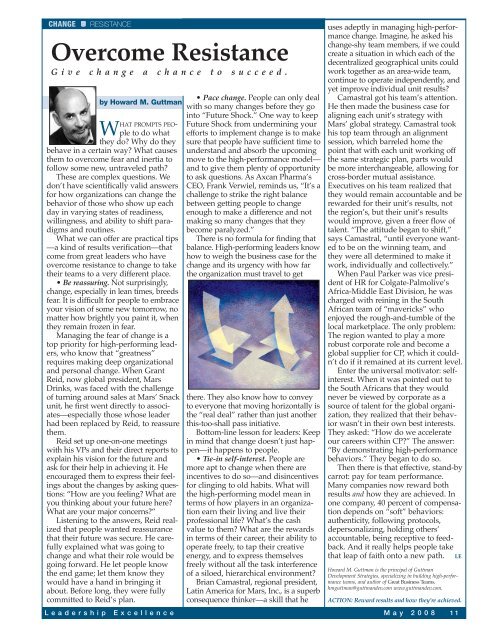Read More - Zenger Folkman
Read More - Zenger Folkman
Read More - Zenger Folkman
- No tags were found...
You also want an ePaper? Increase the reach of your titles
YUMPU automatically turns print PDFs into web optimized ePapers that Google loves.
CHANGERESISTANCEOvercome ResistanceGive change a chance to succeed.by Howard M. GuttmanWHAT PROMPTS PEOpleto do whatthey do? Why do theybehave in a certain way? What causesthem to overcome fear and inertia tofollow some new, untraveled path?These are complex questions. Wedon’t have scientifically valid answersfor how organizations can change thebehavior of those who show up eachday in varying states of readiness,willingness, and ability to shift paradigmsand routines.What we can offer are practical tips—a kind of results verification—thatcome from great leaders who haveovercome resistance to change to taketheir teams to a very different place.• Be reassuring. Not surprisingly,change, especially in lean times, breedsfear. It is difficult for people to embraceyour vision of some new tomorrow, nomatter how brightly you paint it, whenthey remain frozen in fear.Managing the fear of change is atop priority for high-performing leaders,who know that “greatness”requires making deep organizationaland personal change. When GrantReid, now global president, MarsDrinks, was faced with the challengeof turning around sales at Mars’ Snackunit, he first went directly to associates—especiallythose whose leaderhad been replaced by Reid, to reassurethem.Reid set up one-on-one meetingswith his VPs and their direct reports toexplain his vision for the future andask for their help in achieving it. Heencouraged them to express their feelingsabout the changes by asking questions:“How are you feeling? What areyou thinking about your future here?What are your major concerns?”Listening to the answers, Reid realizedthat people wanted reassurancethat their future was secure. He carefullyexplained what was going tochange and what their role would begoing forward. He let people knowthe end game; let them know theywould have a hand in bringing itabout. Before long, they were fullycommitted to Reid’s plan.• Pace change. People can only dealwith so many changes before they gointo “Future Shock.” One way to keepFuture Shock from undermining yourefforts to implement change is to makesure that people have sufficient time tounderstand and absorb the upcomingmove to the high-performance model—and to give them plenty of opportunityto ask questions. As Axcan Pharma’sCEO, Frank Verwiel, reminds us, “It’s achallenge to strike the right balancebetween getting people to changeenough to make a difference and notmaking so many changes that theybecome paralyzed.”There is no formula for finding thatbalance. High-performing leaders knowhow to weigh the business case for thechange and its urgency with how farthe organization must travel to getthere. They also know how to conveyto everyone that moving horizontally isthe “real deal” rather than just anotherthis-too-shall pass initiative.Bottom-line lesson for leaders: Keepin mind that change doesn’t just happen—ithappens to people.• Tie-in self-interest. People aremore apt to change when there areincentives to do so—and disincentivesfor clinging to old habits. What willthe high-performing model mean interms of how players in an organizationearn their living and live theirprofessional life? What’s the cashvalue to them? What are the rewardsin terms of their career, their ability tooperate freely, to tap their creativeenergy, and to express themselvesfreely without all the task interferenceof a siloed, hierarchical environment?Brian Camastral, regional president,Latin America for Mars, Inc., is a superbconsequence thinker—a skill that heuses adeptly in managing high-performancechange. Imagine, he asked hischange-shy team members, if we couldcreate a situation in which each of thedecentralized geographical units couldwork together as an area-wide team,continue to operate independently, andyet improve individual unit results?Camastral got his team’s attention.He then made the business case foraligning each unit’s strategy withMars’ global strategy. Camastral tookhis top team through an alignmentsession, which barreled home thepoint that with each unit working offthe same strategic plan, parts wouldbe more interchangeable, allowing forcross-border mutual assistance.Executives on his team realized thatthey would remain accountable and berewarded for their unit’s results, notthe region’s, but their unit’s resultswould improve, given a freer flow oftalent. “The attitude began to shift,”says Camastral, “until everyone wantedto be on the winning team, andthey were all determined to make itwork, individually and collectively.”When Paul Parker was vice presidentof HR for Colgate-Palmolive’sAfrica-Middle East Division, he wascharged with reining in the SouthAfrican team of “mavericks” whoenjoyed the rough-and-tumble of thelocal marketplace. The only problem:The region wanted to play a morerobust corporate role and become aglobal supplier for CP, which it couldn’tdo if it remained at its current level.Enter the universal motivator: selfinterest.When it was pointed out tothe South Africans that they wouldnever be viewed by corporate as asource of talent for the global organization,they realized that their behaviorwasn’t in their own best interests.They asked: “How do we accelerateour careers within CP?” The answer:“By demonstrating high-performancebehaviors.” They began to do so.Then there is that effective, stand-bycarrot: pay for team performance.Many companies now reward bothresults and how they are achieved. Inone company, 40 percent of compensationdepends on “soft” behaviors:authenticity, following protocols,depersonalizing, holding others’accountable, being receptive to feedback.And it really helps people takethat leap of faith onto a new path. LEHoward M. Guttman is the principal of GuttmanDevelopment Strategies, specializing in building high-performanceteams, and author of Great Business Teams.hmguttman@guttmandev.com www.guttmandev.com.ACTION: Reward results and how they’re achieved.Leadership Excellence May 2008 11






